Maturín
Maturín | |
|---|---|
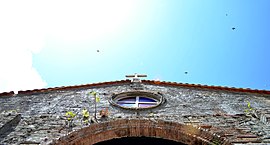    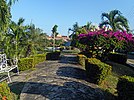 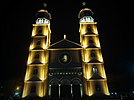 Top:Maturin San Miguel Arcangel Church, Second:Maturin San Simon Church, Especial Lumino-Cromatica Tower, Third:A night view of fountain in Redoma Juana La Avanzadora, Bottom:La Guaricha Zoological Park, Maturin Cathedral (all item of left to right) | |
 Flag  Seal | |
| Nickname(s): "La Ciudad Distinta" (" The Different City") | |
| Motto(s): "La Ciudad más limpia de Venezuela" ("The Cleanest City of Venezuela") | |
 Maturín | |
| Coordinates: 9°45′00″N 63°10′59″W / 9.750°N 63.183°WCoordinates: 9°45′00″N 63°10′59″W / 9.750°N 63.183°W | |
| Founded | December 7, 1760 |
| Government | |
| • Mayor | |
| • Demonym | Maturinés |
| Area | |
| • City | 13,352 km2 (5,155 sq mi) |
| Elevation | 67 m (220 ft) |
| Population (2013) | |
| • Urban | 472,909[1] |
| Time zone | UTC−4 (VET) |
| Area code(s) | 0291 |
| Climate | Aw |
| Website | alcaldiadematurin.gob.ve |
Maturín (Spanish pronunciation: [matuˈɾin]) is a city in Venezuela, the capital of the Venezuelan state of Monagas and a centre for instrumental exploration and development of the petroleum industry in Venezuela. The metropolitan area of Maturín has a population of 401,384 inhabitants. Maturín is also a busy regional transportation hub, connecting routes from the northeastern coast to the Orinoco Delta and the Gran Sabana.
History[]
Foundation[]
December 7, 1760 is the official date of the foundation of Maturín (according to the Venezuelan Academy of History) by the Franciscan missionary Lucas de Zaragoza. However, the Jesuit priest Pablo Ojer found in the Archivo General de Indias a document which proves a previous foundation of the city in 1722.[2] This primitive town was called San Juan de la Tornera de Maturín and its founder was the Spanish governor Juan de la Tornera y Sota.[2] San Juan de la Tornera de Maturín had the category of city for Spaniards, but it did not survive very long because of the lack of population and little economical resources. At the beginning San Judas Tadeo de Maturín (Lucas de Zaragoza gave this name to Maturín) was a Spanish mission created for the conversion of Indians Chaimas and Waraos, who lived next to Maturín. The Spaniards decided to move to Maturín and in the 19th century it received the category of city and the name of San Fernando de Maturín.
Origin of the name Maturín[]

Maturín was named after an Indian chief (el Indio Maturín) who lived with his tribe next to the bank of Guarapiche River. The Indian chief was murdered by a supposed Spanish captain named Arrioja during a battle of the Indians against Spaniards in the actual location of the town in 1718. Since then the place was known as el Sitio de Maturín (place of Maturín).
Some historians concluded that the name Maturín has a French root, not an Indian one. They based their opinions on the legend of a supposed French missionary who had explored this area at the end of the 17th century. The legend says that the missionary (whose surname might have been Mathurin) baptized a young Indian and gave him the name Mathurin.[2] This young Indian became el indio Maturín later. Besides there is a French saint who lived during 4th century whose name was Saint Mathurin. The young Indian might have been named after this saint by the French missionary. However the legend of this supposed French missionary has not been proved yet. On the other hand, other historians disagreed with that theory. They argued that there is a plant with the same name. Besides there are some place names of Indian roots which are very similar to the name Maturín.
Independence war[]
Maturín (as a part of the Province of Cumaná) was on the republican side during the Venezuelan Declaration of Independence on July 5, 1811. Five battles took place in Maturín from 1813 to 1814, including the famous Battle of Alto de los Godos. In this battle the Venezuelan patriots, led by Manuel Piar, obtained a great victory against the Spanish general Juan Domingo de Monteverde. Antonio José de Sucre, José Francisco Bermúdez, José Tadeo Monagas, José Gregorio Monagas and José Félix Ribas were others who fought in the five battles. The last battle of Maturín (1814), however, was a defeat. Persons, who had escaped from Caracas during the military campaign of José Tomás Boves against the republic, came to Maturín to shelter from the Spanish troops. After the battle of Urica (where Boves died) Tomás José Morales, a Spanish general, decided to take the town. The republicans defended the town, but they were beaten and many of them were murdered by Morales. The town was destroyed. Some survivors of the last battle rebuilt Maturín two years later.
19th and 20th centuries[]
Maturín grew slowly during the 19th century. The causes of this lack of population were civil wars (which destroyed the former farming and livestock richness of the region and killed many people) and fatal diseases, such as malaria and yellow fever, which were caused by mosquitoes. In 1909 Maturín became capital of the new Monagas state. Before that the town was the capital of the Province Maturín from 1856 to 1859. In the 20th century Maturín had rapid demographic growth thanks to the discovery of petroleum fields near the town and a health campaign carried out by doctors to eliminate mosquitoes. Maturín has been the headquarters of the Roman Catholic Diocese of Maturín since 1958.
Geography[]
Maturin is located at 67 meters of altitude and 520 kilometres from the country's capital, Caracas. It is right next to the Guarapiche River and it's a crossroad for roads towards the center, the Caribbean coast and the Orinoco River
Climate[]
Maturín features a tropical savannah climate (Köppen climate classification: Aw).
| Month | Jan | Feb | Mar | Apr | May | Jun | Jul | Aug | Sep | Oct | Nov | Dec | Year |
|---|---|---|---|---|---|---|---|---|---|---|---|---|---|
| Record high °C (°F) | 34.9 (94.8) |
35.7 (96.3) |
36.2 (97.2) |
36.8 (98.2) |
36.7 (98.1) |
35.9 (96.6) |
36.8 (98.2) |
37.1 (98.8) |
36.9 (98.4) |
36.7 (98.1) |
35.5 (95.9) |
35.1 (95.2) |
37.1 (98.8) |
| Average high °C (°F) | 30.7 (87.3) |
31.4 (88.5) |
32.2 (90.0) |
32.8 (91.0) |
32.4 (90.3) |
30.9 (87.6) |
30.9 (87.6) |
31.6 (88.9) |
32.3 (90.1) |
32.3 (90.1) |
31.5 (88.7) |
30.7 (87.3) |
31.6 (88.9) |
| Daily mean °C (°F) | 26.2 (79.2) |
26.6 (79.9) |
27.1 (80.8) |
27.8 (82.0) |
27.8 (82.0) |
26.9 (80.4) |
26.9 (80.4) |
27.4 (81.3) |
27.9 (82.2) |
27.9 (82.2) |
27.4 (81.3) |
26.6 (79.9) |
27.2 (81.0) |
| Average low °C (°F) | 21.7 (71.1) |
21.7 (71.1) |
22.0 (71.6) |
22.8 (73.0) |
23.2 (73.8) |
22.9 (73.2) |
22.8 (73.0) |
23.1 (73.6) |
23.5 (74.3) |
23.4 (74.1) |
23.2 (73.8) |
22.4 (72.3) |
22.7 (72.9) |
| Record low °C (°F) | 16.7 (62.1) |
18.7 (65.7) |
18.5 (65.3) |
18.1 (64.6) |
18.3 (64.9) |
16.1 (61.0) |
17.2 (63.0) |
18.3 (64.9) |
20.7 (69.3) |
20.4 (68.7) |
18.3 (64.9) |
18.0 (64.4) |
16.1 (61.0) |
| Average rainfall mm (inches) | 58 (2.3) |
33 (1.3) |
24 (0.9) |
37 (1.5) |
100 (3.9) |
208 (8.2) |
215 (8.5) |
177 (7.0) |
131 (5.2) |
107 (4.2) |
135 (5.3) |
111 (4.4) |
1,336 (52.6) |
| Average rainy days (≥ 1.0 mm) | 9.7 | 5.7 | 4.0 | 4.2 | 10.6 | 18.1 | 19.6 | 17.8 | 12.8 | 12.1 | 14.2 | 12.6 | 141.4 |
| Average relative humidity (%) | 74.5 | 71.5 | 70.5 | 70.0 | 72.0 | 76.5 | 76.5 | 75.5 | 74.0 | 74.0 | 76.5 | 76.0 | 74.0 |
| Mean monthly sunshine hours | 248.0 | 224.0 | 251.1 | 228.0 | 213.9 | 168.0 | 186.0 | 204.6 | 213.0 | 232.5 | 219.0 | 229.4 | 2,617.5 |
| Source 1: Instituto Nacional de Meteorología e Hidrología (INAMEH)[3][4] | |||||||||||||
| Source 2: NOAA (extremes, rainy days, and sun)[5] | |||||||||||||
Law and government[]
Maturín has one municipality: Maturín Municipality; Venezuelan law specifies that municipal governments have four main functions: executive, legislative, comptroller, and planning. The executive function is managed by the mayor, who is in charge of representing the municipality's administration. The legislative branch is represented by the Municipal Council, composed of seven councillors, charged with the deliberation of new decrees and local laws. The comptroller tasks are managed by the municipal comptroller's office, which oversees accountancy. Finally, planning is represented by the Local Public Planning Council, which manages development projects for the municipality.
Mayors since 1990[]
- María Elena de Cañizales (1990–1992) Acción Democrática
- José Enrique López Tablero (1993–1995) COPEI, MAS
- Domingo Urbina Simoza (1996–2000), (2000–2004) Acción Democrática
- Numa Rojas (2004–2008) Movimiento Quinta República
- (2008–2013) PSUV
- Warner Jimenez (2013–2015) Voluntad Popular VP
- Yelitze Santaella (2016-) Partido Socialista Unido de Venezuela PSUV
Economy[]
Maturín is one of the most important cities in the east of the country as its strategic position serves as a bridge to the other states of the region. The city had grown during the last few years mainly because of the increase of the oil industry in the state. However, Maturín has been hit hard by Venezuela's recent economic crisis.[6]
Transportation[]
It is possible to travel there by land or by using José Tadeo Monagas International Airport.
Higher education[]

Public Universities
- Universidad de Oriente (UDO-Monagas) Website (in Spanish)
- (UPEL/IPM). Website (in Spanish)
- (UNA). Information about UNA - Monagas (in Spanish)
- Bolivarian University of Venezuela (UBV). Website (in Spanish)
- Universidad Nacional Experimental Simón Rodríguez (UNESR). Information about UNESR- Monagas (in Spanish)
Private Universities
- (UGMA). Information about UGMA - Maturín (in Spanish)
- (UNICA). Se siguen allí estudios a distancia. Website (in Spanish)
- (UNIMAR). Únicamente se estudia allí carreras de postgrado. Website (in Spanish)
Private Institutes of Higher Education
- Instituto Universitario Politécnico "Santiago Mariño" (PSM). [1] (in Spanish)
- (IUTIRLA). Website (in Spanish)
- (IUTV). Information about IUTV- Maturín (in Spanish)
Places of interest[]
Roman Catholic temples[]



- The church San Simón: the oldest church in Maturín. It was built between 1884 and 1887 and is located in front of the Plaza Bolivar.
- The cathedral Nuestra Señora del Carmen: a catholic temple of Roman style. Its construction began in 1961 and was finished in 1981. It is located on Bolívar Avenue.
Parks[]

- : a zoological park located on Raúl Leoni Avenue.
- : a former zoological park. It lost that category when the Parque de La Guaricha was built. Located on Juncal Avenue.
- : located on Raúl Leoni Avenue.
- : located in Las Cocuizas sector.
- : located on Universidad Avenue, next to the Universidad de Oriente.
- : located in Los Guaritos sector.
Museums, theatres and art galleries[]
- Complejo Cultural de Maturín (Cultural Complex of Maturín): a group of buildings where some cultural institutions are located such as the Art School "Eloy Palacios", the Virtual Library and the (Museum Mateo Manaure). The Francisco de Miranda Square and a pedestrian art gallery belong to the complex.
- Casa de la Cultura (Culture House): a small theatre located on Bolívar Avenue.
- Galería de Arte del CONAC (Art Gallery of the CONAC): it belongs to the network of art galleries of the CONAC. Located inside the Centro Comercial Guarapiche.
Others[]
- Amana del Tamarindo: a small town located thirty minutes from Maturín. It received its name from a tamarind tree located in the town, like the Amana River. Under this tree, which still exists, was the birthplace of José Tadeo Monagas.
- Plaza Bolívar: the main town square of Maturín and also the oldest of the city. In front of it is the Palacio de Gobierno (built in 1942), where the governor of the state of Monagas carries out his duties.
Gallery Images[]

La Guaricha Park

Typical tradition, El Mono

Movie Planet Cinema

Mateo Manaure Museum
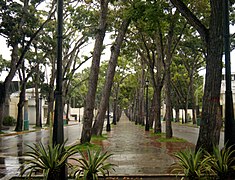
Bolívar Avenue in Maturín
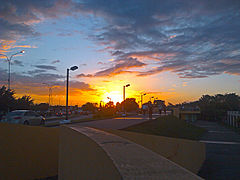
Sunset in Maturín
Sports[]
Sports facilities[]
- Estadio Monumental de Maturín
- Complejo Polideportivo de Maturín (Sports Complex of Maturín).
Teams[]
- Monagas Sport Club: the local soccer team.
References[]
- ^ http://www.cne.gov.ve/web/normativa_electoral/elecciones/2013/municipales/circunscripciones/Monagas.pdf 6 parishes made the population of Maturín: Alto de Los Godos, Boquerón, Las Cocuizas, San Simón, Santa Cruz, CM Maturín
- ^ Jump up to: a b c González Oropeza, Hermann (1985): Historia del Estado Monagas. Ediciones Amon C.A., Caracas. (Biblioteca de Temas y Autores Monaguenses; Colección Guanipa; ensayos e investigación).
- ^ "Estadísticos Básicos Temperaturas y Humedades Relativas Máximas y Mínimas Medias" (PDF). INAMEH (in Spanish). Archived from the original (PDF) on 15 June 2013. Retrieved 27 October 2012.
- ^ "Estadísticos Básicos Temperaturas y Humedades Relativas Medias" (PDF). INAMEH (in Spanish). Archived from the original (PDF) on 15 June 2013. Retrieved 27 October 2012.
- ^ "Maturín Climate Normals 1961–1990". National Oceanic and Atmospheric Administration. Retrieved 12 August 2015.
- ^ Casey, Nicholas (25 December 2016). "No Food, No Medicine, No Respite: A Starving Boy's Death in Venezuela". Retrieved 13 January 2019 – via NYTimes.com.
External links[]
| Wikimedia Commons has media related to Maturín. |
- Maturín
- Cities in Monagas







